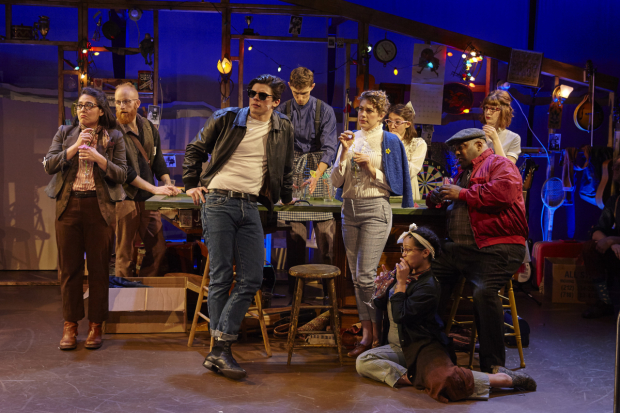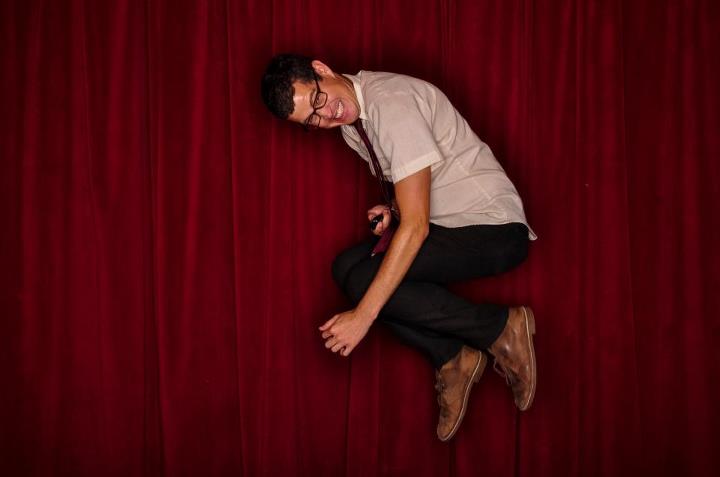

From Pipeline Theatre Company, Folk Wandering tells the stories of three different women across three different eras - Rosealia (1911), Kai (1933), and Hannah (1955). Conceived by Andrew Neisler and Jaclyn Backhaus, it's a sweeping, vibrant piece that raises questions about the American dream, the past, and moving on from tragedy. It's also got great music: a number of indie/folk-style songs developed collaboratively by a group of singer-songwriters. We spoke with director and co-conceiver Andrew Neisler about the creation process, building a collaborative space, and the incredible detail of some of the show's props.
It sounds like creating this show was a very collaborative process. Was there anything specifically you did with the cast and/or creative team to foster that ensemble-type atmosphere and get everyone comfortable working together?
When we first started working on it, about six or seven years ago, it was mostly a community of people that had gone to school together, so we already had a pretty established vocabulary and rapport with each other. I worked with Liz Swados a lot at NYU, and some of the other collaborators on the project also worked with her. And one of the things she sort of instilled in us was this sense that – not to judge the work – you can’t edit and create at the same time, right? So not to judge the work while you’re making it.
So we just broke off into groups and generated a ton of music and then we’d come back together and flesh things all the way out to fruition until we had this big beautiful song. And only then would we sort of go, “Actually maybe this doesn’t have a place in the show.” But because of that it was just a very generative time.
Folk Wandering has obviously gone through several stages, and I’m sure you’ve had to hone it down a lot since 2010.
Yeah.
How do you make that decision on what to cut and what to leave in? And when did you know you finally had something that was ready for an audience?
Well, the truth is we did a lot of work on it when we first started creating it. We did some readings through with Fresh Ground Pepper, which is another company that Jaclyn Backhaus and I co-run. And then we did some Joe’s Pub concerts and we did a couple Ars Nova shows. And then we kind of put the whole thing on the shelf for a while, and didn’t really touch it for two years or so.
And then Ari Schrier at Pipeline started talking to Jaclyn and I about bringing it off the shelf and dusting it off and putting it up again. That was when we started digging back into it and looking at how the world had changed since we first started making it, and how the piece wanted to shift in that new context. Basically we kind of just got the whole crew back together again and read through the play. And we don’t really say no to each other, so when someone is like, “Hey, I think this song needs to go,” we usually just cut it. Cause if everybody’s not on board for something, then we don’t usually feel good putting it out there. We want the whole team – or I, especially – want the whole team to be proud of, confident in, and passionate about the material. So it’s usually like the squeaky wheel gets the grease. (Laughs) If someone wants to cut something, we’ll cut it. And then we’ll have a conversation about what, if anything, needs to go in its place.

There’s so many great characters in Folk Wandering that I think it’s easy for the audience to see themselves in at least one of these characters. Is there a certain character that you see the most of yourself in?
Oh my god. That is tough. Wow, let me think about that.
I like to think that I see myself in Harlan: the factory boy who is just trying to figure out how to grow up and fall in love and be respectful of other people. And I do see a younger version of me in him. But you know, I think what’s also sort of bizarre is that when we first started developing it I definitely identified with a lot of the younger characters in the piece. And just recently, like this past week when we were in previews, I started realizing how much I identify with the parents in the tenement story, and how surprising that is to me. (Laughs) That now I feel like their struggle of trying to create a safe and fruitful environment around their family and for their kids – I mean I don’t have any children, but even just as a director, the task of building a collaborative and safe space for your team and the artists around you – there’s something about that that I really connect with as well.
Anything you’ve learned from directing Folk Wandering or just working on it that you plan to take with you to your next project?
In general, I’ve learned so much from Folk Wandering because I’ve been working on it for so long. You know, it’s one of the first projects I started working on – ever. And so it’s hard to pinpoint one thing. But I definitely think I’ve learned that even though I am the director, to not always talk the most, and to listen – to listen to my collaborators, to listen to the characters, to listen to the cast and the writers. Cause I think Folk Wandering’s strength is that it has so many points of view woven into it. The stories are very short and simple, because the play’s so dense. And just being able to try to absorb as many histories and as many experiences as I can and to get those out into the room really strengthens the piece.
And then also just something that’s been kind of reaffirmed for me in Folk Wandering is that the vibe of your rehearsal room is what it’s going to feel like to be in your audience. And so I think, even more so trying to set the tone of a loving, warm, open rehearsal room, because that’s what I want it to feel like to see the play. And that is definitely something I want to take with me into future projects.
What one item in Folk Wandering would you take if you were one of the characters digging around in the attic?
Oh, man. Well funny enough there are a couple things on the set that are mine.
Well, there you go.
But let’s say I’m automatically going to get those back, and then what else would I take.
This is maybe a little bit of a cop-out, but the papers that Rosealia uses to activate her story, the articles, they are actually hand-written like old articles. Our props designer just did a really detailed job with those, and so they’re actually just kind of amazing to sit down and read. There’s little fictions in there that no one will ever get, that I would love to just be able to take home and have a cup of coffee and read them all. They’re so funny and absurd and great.